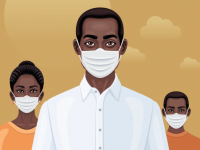As the pandemic continues to evolve across Africa, there is a need for African Union Member States to re-evaluate, re-strategize, and re-invigorate their COVID-19 response activities across the continent to ensure their countries are prepared to handle an inevitable second, and potentially third wave of cases. In an effort to limit transmission and achieve pandemic control on the continent, Africa CDC is proposing the following measures to be taken by all Member States:
Remain vigilant
Countries should adapt or adopt best practices, strategies, guidelines and recommendations proposed by the Africa CDC and World Health Organization (WHO), aimed at limiting transmission. Measures taken should strike a balance between saving lives and minimizing the impact of the pandemic on the economy and social wellbeing of citizens. In doing so, countries should:
- Strengthen surveillance systems to rapidly identify and isolate new
cases as well as monitor trends to inform response efforts;
- Generate additional evidence and science necessary for making
informed decisions and reallocate resources to where they are most
needed. These efforts could include implementing rapid mortality
surveillance, sero-survey studies, and other systematic and
implementation health research;
- Enhance the implementation of Partnership to Accelerate COVID-19
Testing (PACT) by ensuring that tests are conducted, cases are isolated
and cared for, and contacts are traced;
- Continue to strengthen the health systems to address all public health
challenges, especially provision of essential health services; and
- Review and evaluate the public health and social measures that were
used during earlier waves of transmission to better understand which
were effective, how they impacted other critical health care delivery
systems, and their acceptability and level of compliance by the public.
Plans and triggers for re-instating these should be reassessed.
Countries experiencing an increase in new cases should critically evaluate the implementation status of all infection prevention and physical distancing measures in place, address barriers to their implementation, and support institution of additional restrictive measures where and when needed in place as guided by data from surveillance programs. These measures include:
- Continued widespread testing by introducing rapid antigen
tests that can give results in 15-30 minutes, especially in
hotspots;
- Ensure access to personal protective equipment (PPE) and
testing supplies;
- Improve and increase active case search for improved case
identification, isolation and care, and tracing of contacts;
- Reinforce field investigation to identify hotspots and specific
drivers of infection spread for targeted intervention; and
- Increase public health messaging campaigns including risk
communication, to reinforce public health and social measure
adherence.
Countries should continue to implement infection prevention and control policies, public health and social measures and guidelines that they found effective in curtailing the pandemic. Specifically, Member States should:
- Continue with expansion of access to testing services until positivity rate falls below 5% and maintaining test-per-case ratio is above 10 at all times
- Sustain active case search for improved case identification, isolation and care, and tracing of contacts;
- Generate additional data and evidence to guide the adjustment of existing public health measures and improve the public health response.
- Continue public health messaging campaigns including risk communication, to reinforce public health and social measure adherence.
They cautioned member states experiencing a decline in the number of new cases are advised to:
- Continue to ensure access to testing to make sure the
positivity rate is below 5% and maintain test-per-case ratio is
above 10 at all times.
- Ensure close monitoring of trends in the number of new cases
reported even when intensify active case search and field
investigation to sustain the down-trending of cases. Cases
should be promptly isolated and cared for, and contacts traced.
- Generate additional data and evidence studies such a
sero-surveys and rapid mortality surveillance
- Continue public health messaging campaigns including risk
communication, to reinforce public health and social measure
adherence.













